Review: Nokia E7, part 6 (Navigation, Utilities, Homescreens, Wrap-up)
Score:
82%
It's big, it's black, it knows where it is and it's surprisingly thin. Here's the sixth, and final, part in our in-depth review of the retail Nokia E7. I look at the built-in mapping and navigation, at additional applications, both preloaded and supplied via the on-device store, at its homescreens, plus I try to work out where the E7 fits into the smartphone world of 2011. Be sure to also check Part 1, Part 2, Part 3, Part 4 and Part 5 of our E7 review so far.
Mapping and navigation
Given the late date of the E7's launch firmware (v13.016, 27 Jan 2011), it's gratifying to see Ovi Maps 3.6 supplied out of the box, complete with the must-have multi-touch control, social location sharing and over-the-air country maps download over Wi-fi. See our story on what's new for Maps v3.6.
With the more detailed maps that 3.6 also brought, plus a slicker interface and the location sharing, and with the use of that large 4" screen that stays full readable even in bright sunlight, navigation on the E7 is largely a pleasure when driving. The only small caveats are that you might have to research an in-car holder that's wide enough to take the device - and I'll wager that there will be people who simply wedge the E7 in landscape/opened mode in an appropriate place on their car's dash. Plus the somewhat weedy loudspeaker struggles a bit to make itself heard for spoken instructions, especially as its placed on the E7's flush bottom.
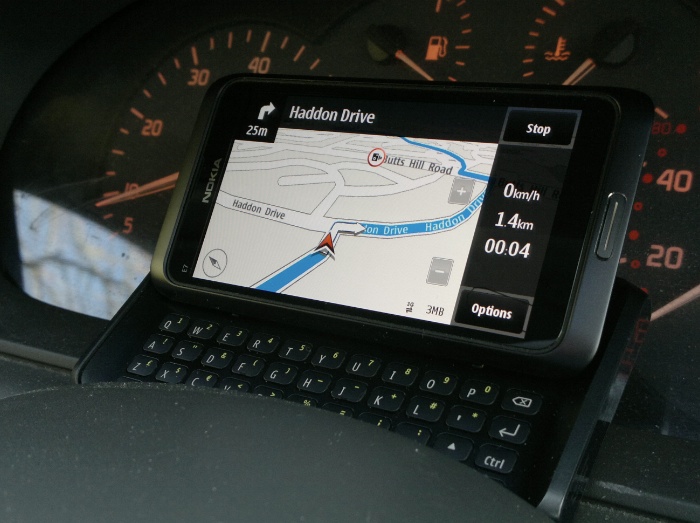
Pedestrian use is a little more clumsy due to the E7's size. You'll be wanting to open the keyboard to type in place names and it's quite an imposing device both for this and, at 176g, when generally just held in hand while walking. In fairness though, it's still a whopping 35g lighter than the E90, the device that the E7 arguably replaces, so it would be churlish to complain - especially when non-Symbian smartphones are all creeping up in size as well - the HTC Desire Z is heavier and the Milestone 2 is only marginally lighter, while devices like the Desire HD and HD7 are physically larger in terms of frontal area.
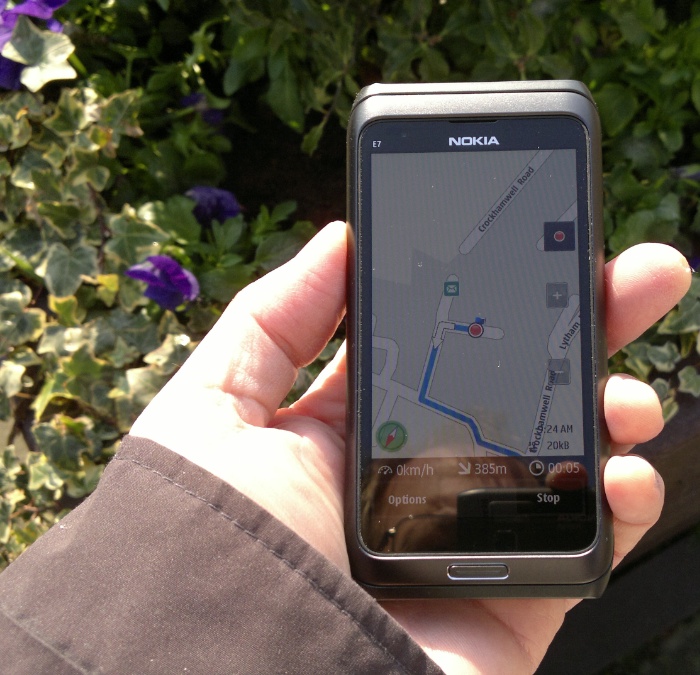
Using the E7 as a pedestrian sat-nav in full sunlight - the CBD display works very well...
Overall then, the Nokia E7 excels in this area and I had no complaints.
Ovi Store and OS updates
Out of the box, the E7 comes with the very latest Ovi Store client (v2.04, complete with blue/green start screen, an easy way of telling). As with Maps, this is a pleasure to use on the huge capacitive touchscreen and CBD display. Yes, I know some other mobile platforms have had 4" capacitive touchscreens for a year or so now, but it's still a novelty on Symbian, so indulge me a little here.
Nokia's Ovi Store has come a long way since its debut a year ago, and layout and responsiveness are fine, though my single biggest criticism from day one remains - once you've installed an application you're reliant on the app itself going online to check for updates, there's no way for the Ovi Store client to manage these or even notify you.
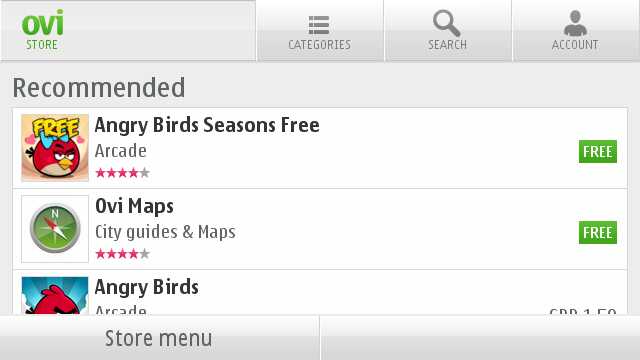
It's appropriate to mention the application catalogue itself, now getting on for 20,000 genuine 'apps' (note that I've already subtracted the number of ringtones and personalisation items). Much is made of the larger numbers for (for example) Apple's iOS store, but most people don't (shock, horror) need 300,000 applications, nor even 20,000. There are plenty of decent applications for Symbian (and especially plenty of good graphics-accelerated 'HD' games, which play beautifully on the large E7 display), though some of the trendier cloud-centric/synced applications like Dropbox, Evernote and even Kindle are conspicuous by their absence. With Symbian's long term future now deprecated in favour of Windows Phone, it's perhaps unlikely that these application gaps will now be filled at all.
There are a number of must-have free downloads from the Ovi Store, though these will of course vary slightly from person to person. I'd recommend you make a beeline for Skype , for Nimbuzz, and for Podcatcher, since IM of any kind is conspicuous by its absence and since Nokia Podcasting never made the jump from S60 5th Edition to Symbian^3.
Application and OS updates are, as ever, delivered through a variety of methods. Rather confusingly. 'Sw_update' in the Applications folder shows incidental OS and built-in application updates, while Device manager shows the underlying firmware version and will check for wholesale firmware updates. As will Ovi Suite, should you plug the E7 into a PC. So no shortage of options then, none of which involve wiping the device or losing data, thankfully.
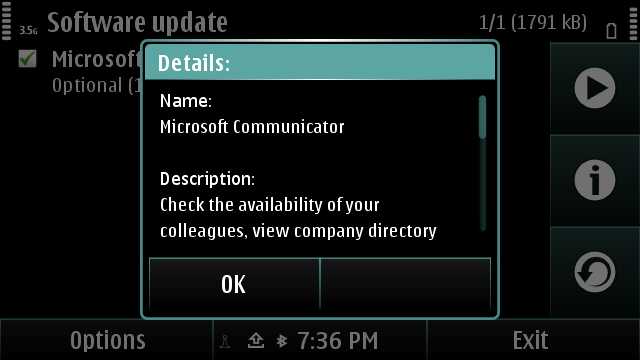
At the time of writing, early March, the only update seems to be the addition of 'Microsoft Communicator', a utility that ties the E7 into Microsoft Office Communications 2007 R2 or Lync 2010 Server. Good to see a genuine enterprise application available, but I'd still like to see more, to help the E7 further differentiate itself from the N8.
And yes, I do have to mention the promised 'next generation' web browser that has been imminent for Symbian now for a month or two. I do have confidence that it will arrive - at some point - and I'd expect it to arrive as a firmware bump because of all the OS modules which hook into Web.
Searching the E7
Nokia's Symbian smartphones have had a global search utility for many years and it's present and correct on the E7 too, letting you type in a search string and have it scanned for across Contacts, Messages, Mail, Calendar, and so on, or else you can explicitly tap through to a content type (e.g. Calendar) and just search in this, to save time.
Symbian^3 added a 'Search' widget too, working better on the E7 than on the other phones by virtue of having a full keyboard available immediately, helpfully offering the choice of searching Google or local content with a single tap. When you first add the 'Search' widget, it actually says 'Web', but the very first time it performs a search you'll get a pick list of Bing and Google and thereafter this search engine name becomes the label in the widget. Which all makes sense, even though I can't really believe anyone's going to pick Bing instead of the big 'G' here.
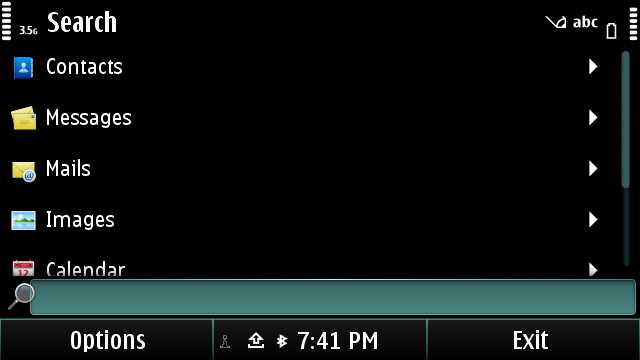
The whole experience, especially searching on the device, works rather well on the E7, in opened mode, ready to type in a new search query or amend an existing one.
Miscellany
In any Symbian smartphone from Nokia there are going to be miscellaneous applications that add value, even if we haven't mentioned them so far in our write-up. Of particular note on the E7 are:
- Dictionary. Rather than being a simple native language dictionary, there are dozens of extra language data sets which can be installed, giving a primitive foreign language dictionary, and one that works better on the E7, again because of the ease with which you can type in words. Dictionary started life in the non-touch world, so the experience isn't great throughout, but it's built-in and the extra languages are free, so why not try it?
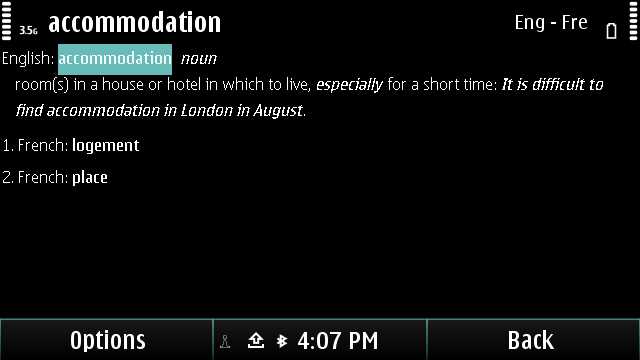
- Zip manager. Long an unsung hero of Symbian, this licensed tool (from Epocware), the main use for this is handling ZIP files that you might receive by email or download from a web site. It's fast and it's flexible and it's comforting to know that it's built in for when you most need it.
- Notes. This is particularly useful as you can set the 'Slide handling' (in 'Settings') to initiate many things, including a 'New note'. With Notes being lightning fast to launch, this means that, from the homescreen, you can simply open the E7 and be ready to start typing away within about a second. For a research or journalistic task, this speed and flexibility is very useful.
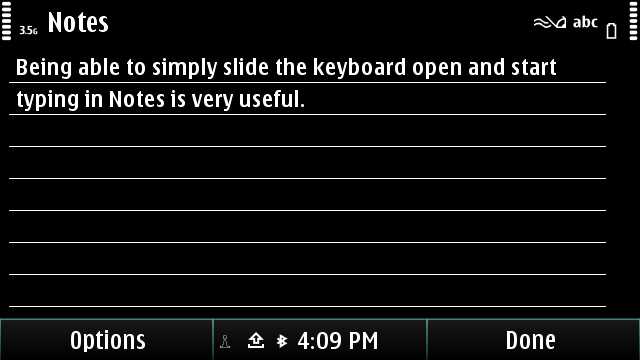
- Recorder. In contrast, Recorder had been a Symbian stalwart and is now almost unsuable. It seems that a bug in the Symbian^3 version (also found on the N8 etc) means that, even on the 'highest' quality setting, voice notes are distorted and uncomfortable to listen to. Best avoided until Nokia fix the application properly.
All about homescreens
As with the other Symbian^3 phones, there are three homescreen 'panes' by default, but their functionality and setup is even more important on the E7 because of the huge unique selling point of the 'opened on desk' use case. The 4" screen props up naturally at a good angle for keeping your eye on incoming email, new social updates, breaking news - plus of course, the time and date. And much more besides.
This sounds a little trivial, but you have to experience a smartphone capable of this laptop-like trick to understand the benefits. Of course, after a set period of time, Symbian will kick in and dim (and then eventually turn off) the screen, rather ruining the effect, but a single keypress (e.g. 'shift') is enough to bring the display back. And, if you're really keen, you can set the screen to stay on permanently - just make sure you keep the charger plugged in as well.
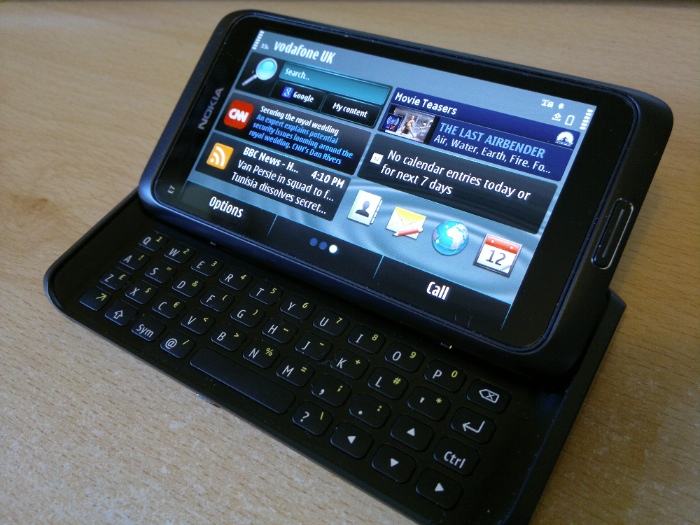
The homescreen setup is the same as on the other Symbian^3 phones, with six widget panels per homescreen. You'll have read elsewhere that for my N8 I eventually opted to just stick to the one homescreen, for ease of access to information, to get everything at a glance while in-hand and on the move. For the E7, I wouldn't go this far, because I'd be far more likely to be using the E7 in 'opened' mode, either sat on a desk or briefcase or just a lap. In this mode, it's quite natural to swipe homescreens and access extra sets of online information.
The E7 comes with suggested widgets in all three homescreens, though there's a heavy emphasis on online content services and the first thing you should probably do when starting out with the E7 is take off all the services you don't need - they'll be draining your device's bandwidth, your processor and your RAM. I ended up with two full homescreens on the E7 and I can easily see how others might want to overflow (or simply re-categorise) widgets to part fill the third.
A word of criticism though - the main homescreen/Apps/Menu button is centrally placed at the bottom of the E7 display. While fine for 'closed' use, this sits high up the display when the E7 is opened, meaning that to press it you've either got to brace the device hard with your left hand while pressing with the right or, better, 'pinch' the display and button using thumb and middle finger of the right hand. It's hardly ideal, especially for a button you're going to want to press quite a lot, for showing the main app menu, for showing the homescreen, for switching running applications.
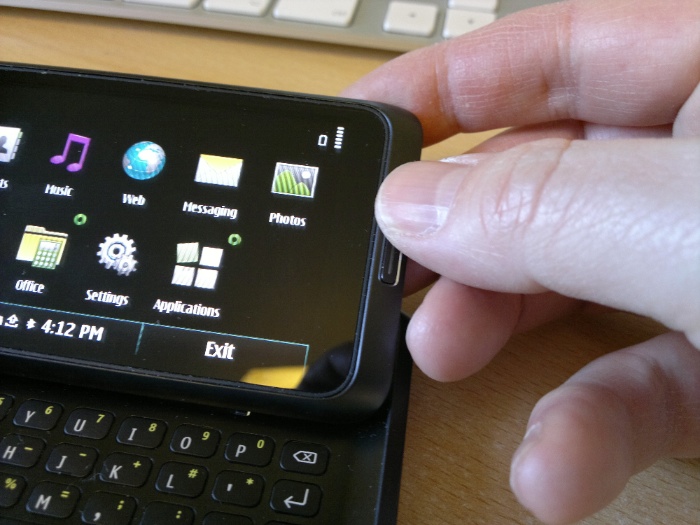
What's needed is a keyboard-based button to achieve the same effect, so that you don't have to lift your fingers from it. There's an ugly workaround by tapping on 'Options', then 'up' twice on the arrow keys and then 'Enter', to bring up the multitasking menu - but it's far from ideal. What's needed (now that Nokia in its infinite wisdom hasn't given us a hardware Menu/home key on the keyboard) is an OS extension or even a third party utility to map a control keypress (e.g. Ctrl-h or Ctrl-s) to return to the main homescreen. Here's hoping. In the meantime, practise your screen pinching.
19,000 words later... the Verdict
Summing up the Nokia E7 is easy enough - estimating how successful it will be is a lot harder. The E7 is a stunning piece of hardware design and Nokia deserve every plaudit for the build quality. Comparing it to the N97, its closest living ancestor, the body of the E7 is a good two to three mm thinner, all the while encompassing a far better keyboard and larger screen. The E7 fits in far more with the modern trend towards 'thin is in', genuinely surprising people with its pop-out keyboard parlour trick. Moreover, the keyboard is very usable and the E7 is largely a pleasure to use in opened/laptop mode - Nokia reckons this is the best phone keyboard it has ever made and I wouldn't argue the point.
Even compared to many of its qwerty keyboard rivals from the wider smartphone world (e.g. HTC Desire Z), the E7 still shines in terms of its hardware, being of simply far higher quality at every turn. Software will be an issue for some, of course, it's unlikely that an existing Android or iOS user will switch platforms to Symbian just to get the E7's metallic goodness, and in that regard the E7 makes more sense as an upgrade from the Nokia 9500, 9300, E90 and even E71 and E72, offering the very latest version of Symbian and a massive dollop of 2010/2011 multimedia compatibility, with only a few software omissions from the application set that a previous user might be expecting. And even here, we can expect a significant number of upgrades and additions to the E7 over the next year to sweeten the pill.
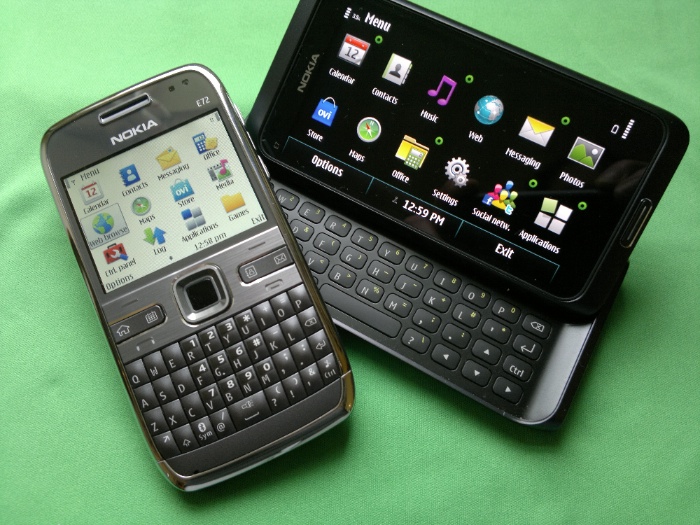
The biggest problem the E7 has is its own sister device - the rightly famous N8. Despite costing significantly less, the N8 has the same internals as the E7, plus a (very) high specification auto-focus camera, the microSD expansion, the FM transmitter, the decent loudspeaker, the 2mm charging and the 'changeable at a pinch' battery - all features which have been dropped for the E7 in the name of keeping the form factor as thin as possible. It's a long list and only you, as reader, know whether there are enough omissions here to counterbalance the sumptuous screen and keyboard.
In a sense, Nokia won't be too upset if you decide to buy the N8 instead of the E7 - it's still a high value sale - but the E7 will remain something of a disappointment to hardcore Communicator fans who are looking to have the 'ultimate' smartphone, the one with the best of everything. They had this in the E90 (for its day), for example, while the E7 will appeal to those whose lives revolve around messaging, email, social networks, multimedia and navigation, leaving the rest of the high ground for the N8.
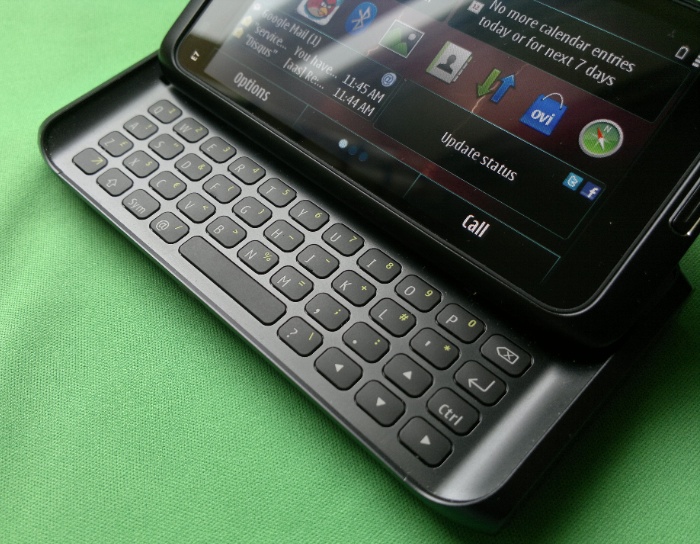
In the wider world, the E7 will perhaps struggle more, given that there are alternatives. After all, the N8 stands alone in terms of its USP (unique selling point), its camera - you want the best camera in your phone, you buy an N8. You don't even look anywhere else. But the E7, despite its build quality and overall design, doesn't have such a USP and has to fend off competition from the aforementioned Desire Z, the Milestone 2 and the HTC 7 Pro, to name but three of last year's models. There are others coming out (already announced at MWC) in 2011, including the Sony Ericsson Xperia Pro. All of these devices get close to (or even exceed) the E7's specification (even if they can't match the build quality and feel in the hand), while also offering compatibility with the Internet-centric world of Android or Windows Phone. In short, the E7's got its work cut out.
This being All About Symbian, of course, there's a distinct chance that you've previously owned a Communicator (of whatever vintage) and I'm sure you'll have strong feelings on this latest device in the marque. Some will feel it's a compromise too far, but others, I'm sure, will appreciate the E7 for what it is, a strong qwerty-based smartphone with a display to die for and with a build that'll last it a lifetime.
Steve Litchfield, All About Symbian, 8 March 2011
Appendix: See also the previous parts in this Nokia E7 review series:
Nokia E7, part 1 - Overview and Detailed first impressions
Nokia E7, part 2 - Camera and Camcorder functions
Nokia E7, part 3 - Multimedia and Gaming
Nokia E7, part 4 - Communications and PIM
Nokia E7, part 5 - Internet, Security and Productivity
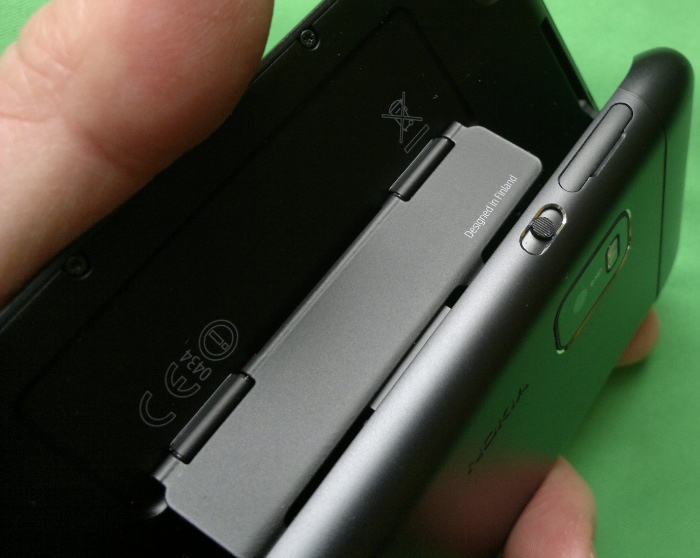 Spilling its mechanism - the E7's robust hinge...
Spilling its mechanism - the E7's robust hinge...Reviewed by Steve Litchfield at
